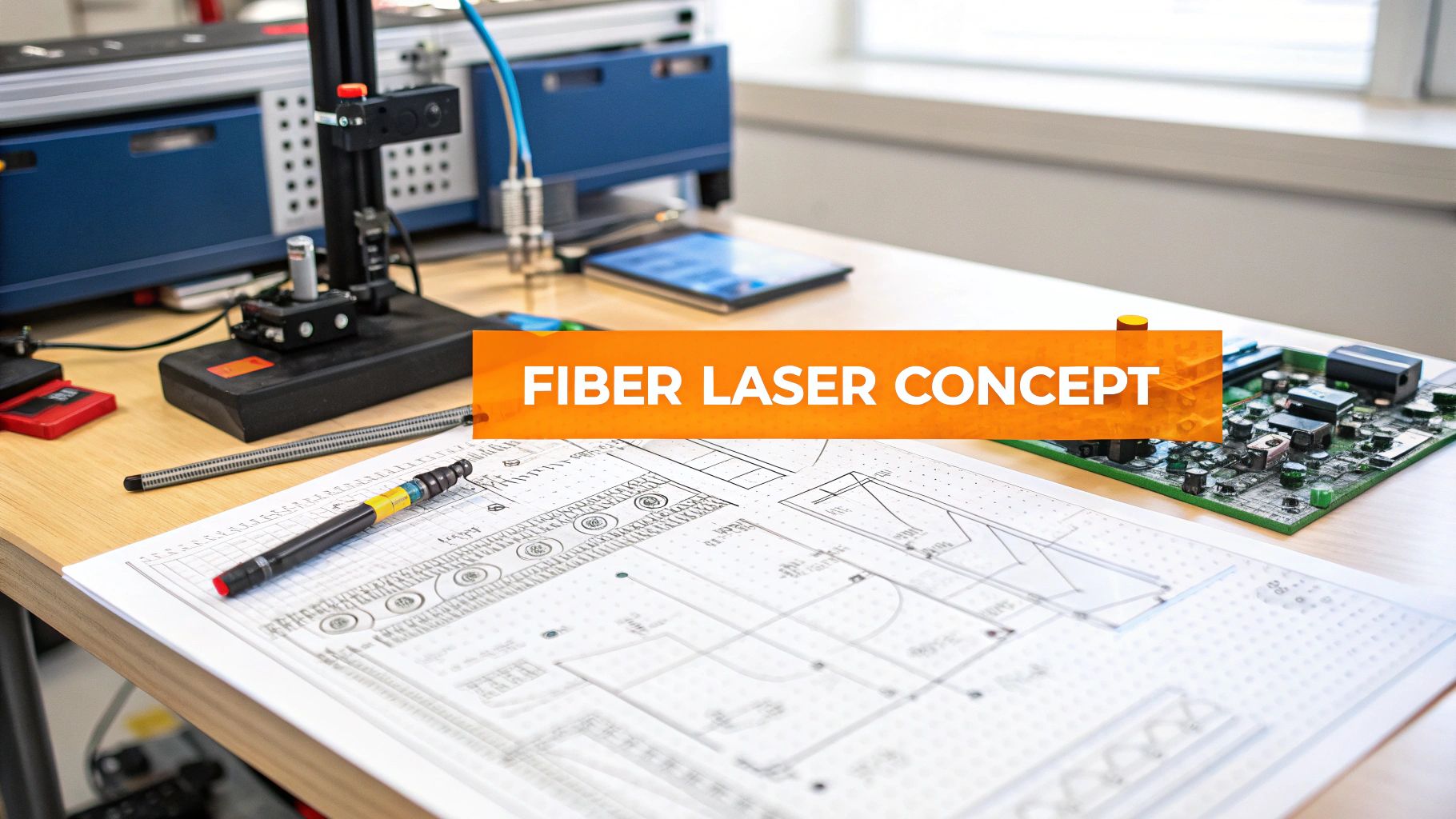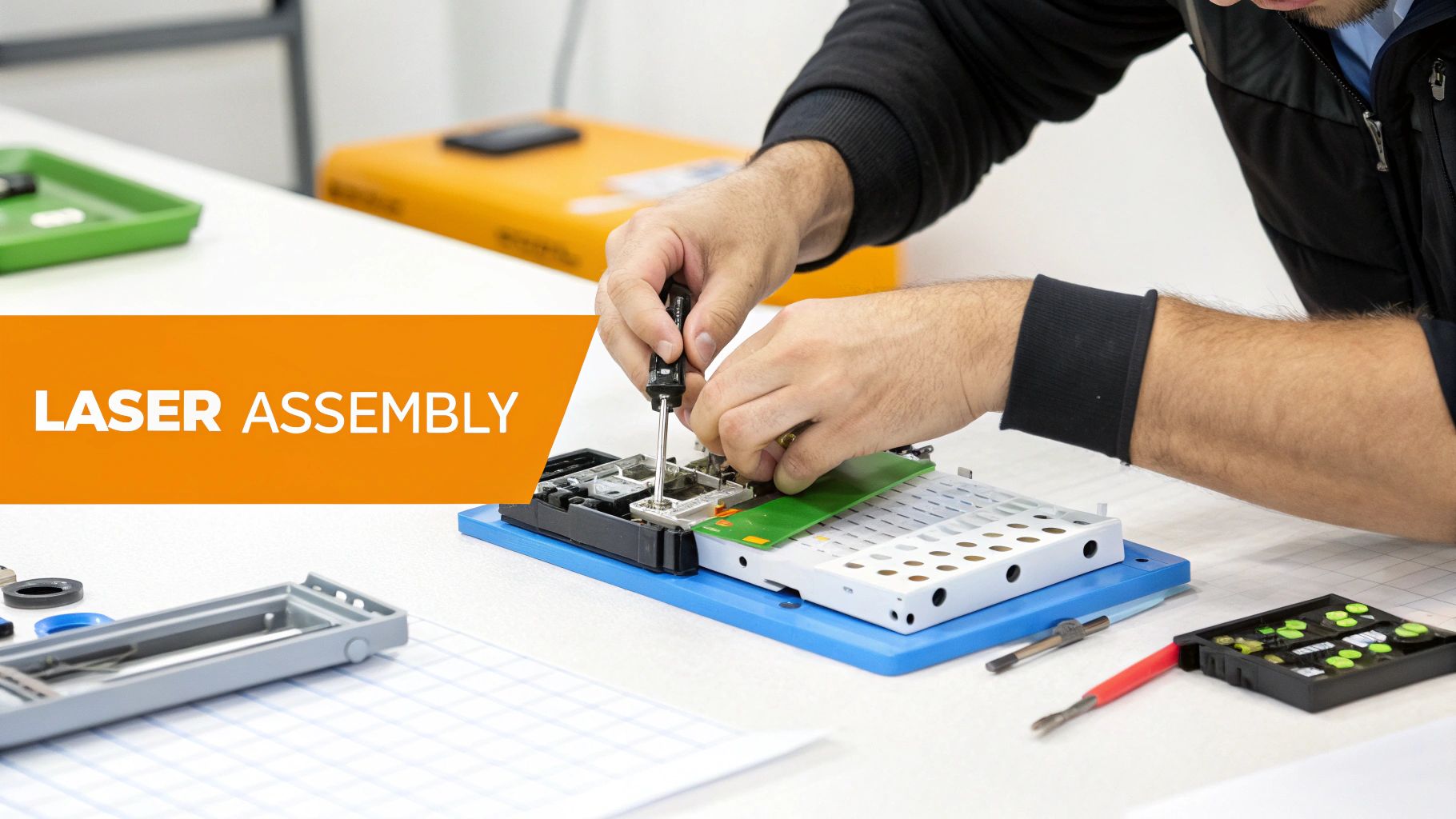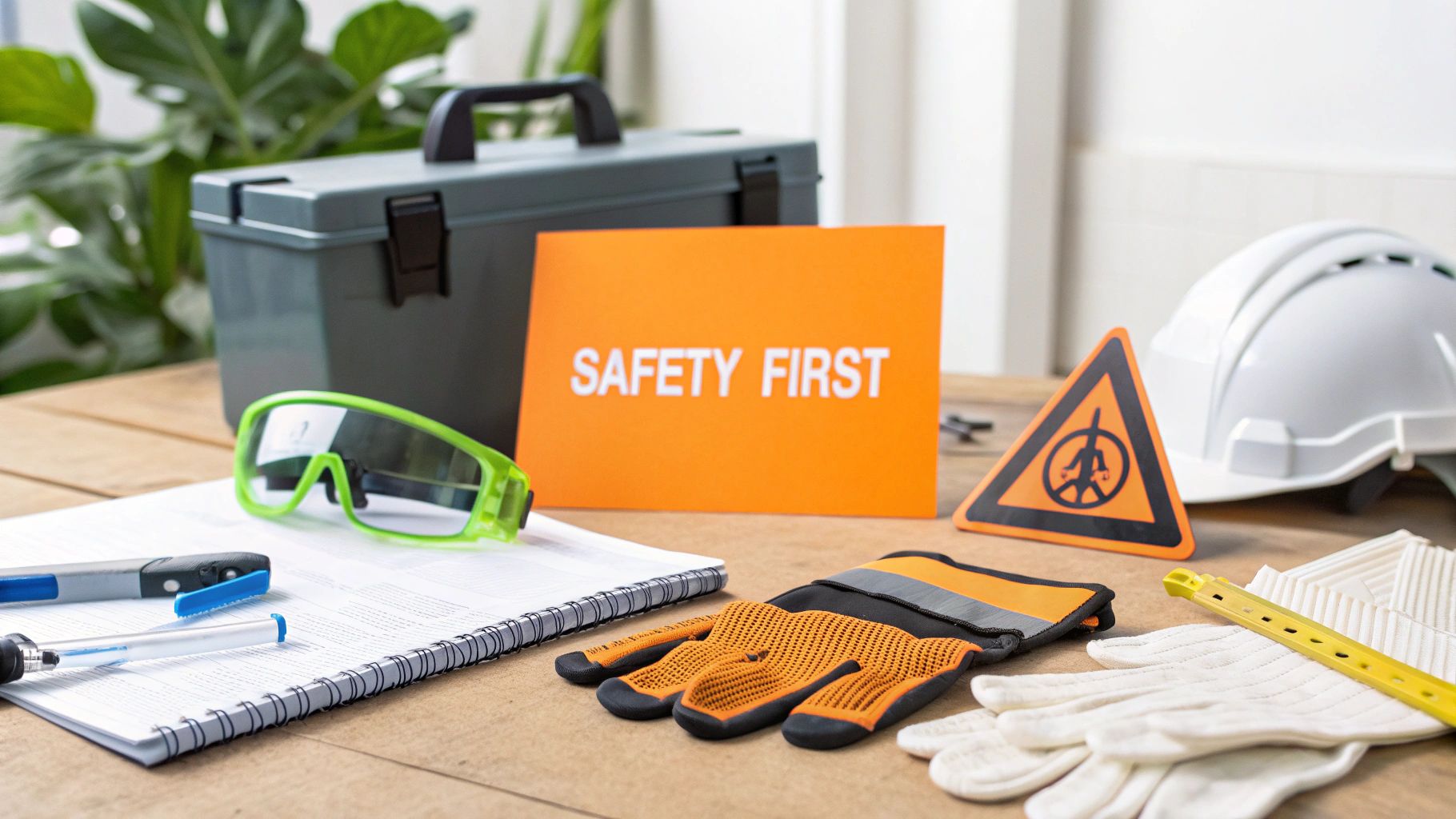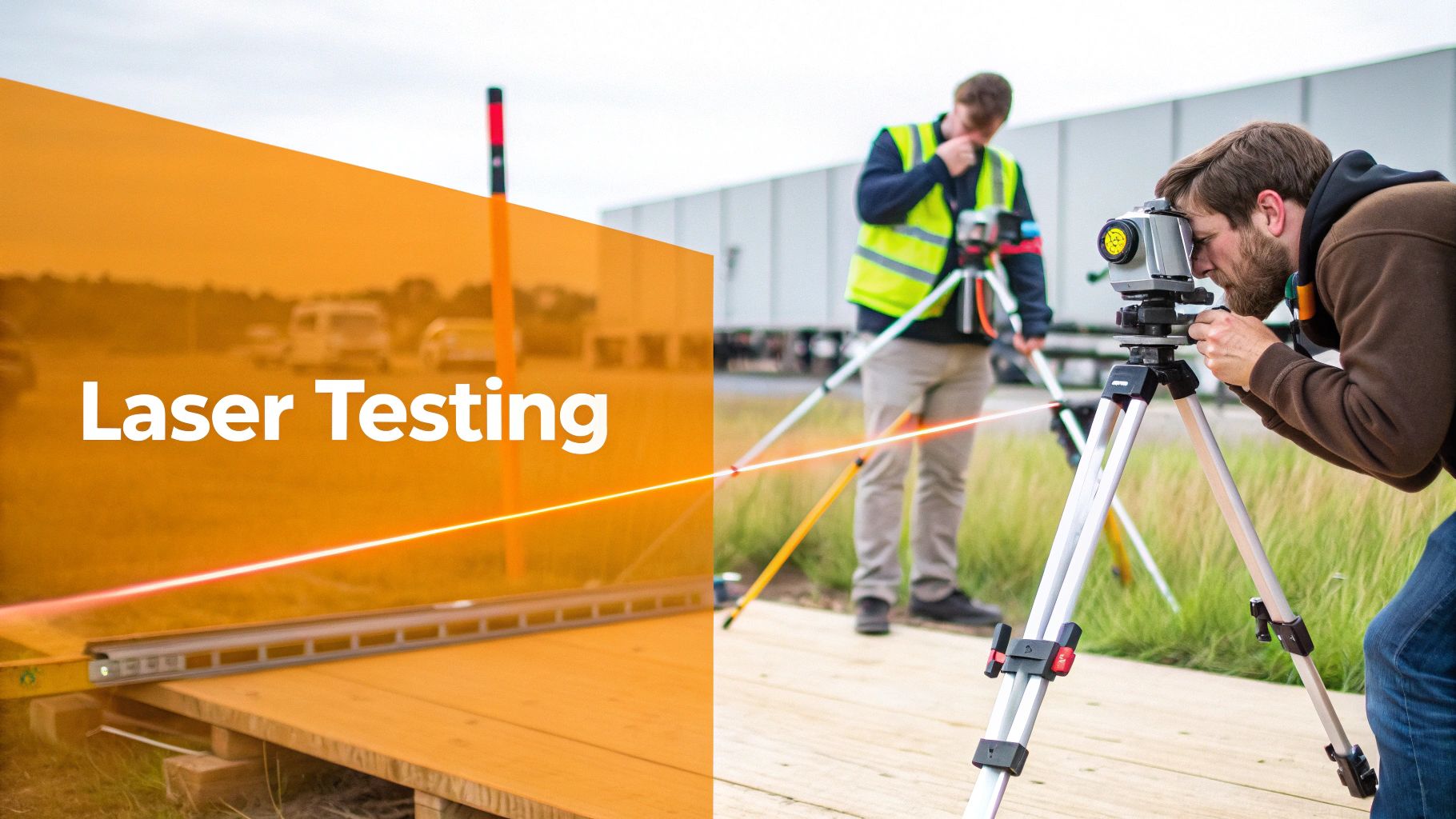The Science Behind Homemade Fiber Lasers

Fiber lasers distinguish themselves from traditional lasers through their use of optical fibers as the gain medium. This difference significantly impacts the laser's operation and the light it produces. Conventional lasers employ mirrors to reflect light through a gain medium. Fiber lasers, however, confine the light within the fiber itself. This results in a highly efficient system generating a high-quality beam.
This brings us to the core of what sets fiber lasers apart.
The Core Components of a Fiber Laser
Three key components work together to create the magic of a fiber laser: the gain medium, the pump source, and the resonator. The gain medium, an optical fiber doped with rare-earth elements like erbium or ytterbium, is where light amplification occurs. These dopants allow the fiber to absorb light from the pump source and emit it at a specific wavelength, amplifying the light signal.
The pump source, usually a laser diode, provides the energy to excite the atoms in the gain medium. It's like the initial spark that ignites a larger flame. You might find this interesting: How to master...
The resonator, formed by fiber Bragg gratings or mirrors at the fiber's ends, provides feedback for the amplified light. This feedback ensures repeated amplification of the correct wavelength, resulting in a coherent and intense laser beam. This interaction between the components produces the unique properties of a fiber laser. However, building a homemade fiber laser presents significant difficulties.
The Challenges of a Homemade Fiber Laser
Building a homemade fiber laser is surprisingly complex, despite the seemingly straightforward principles involved. Precise component alignment, specialized equipment like fusion splicers, and the high cost of doped fiber are substantial obstacles. Furthermore, working with high-power lasers demands a thorough understanding of laser safety to prevent accidents.
These challenges currently make homemade fiber lasers impractical for most hobbyists. The history of fiber lasers, from their 1961 invention to 1990s commercialization, demonstrates the long journey of technology becoming accessible. Learn more about the evolution of fiber lasers: Fiber Lasers. Advancements like self-cooling silica fibers provide a glimpse into a future where such projects might be more feasible.
Reality Check: Can You Build a Homemade Fiber Laser?

Building a fiber laser at home has a certain appeal. It feels like a futuristic project, pushing the boundaries of DIY. But it's crucial to be realistic about the challenges involved. This isn't a simple build. Creating a fiber laser from the ground up requires specialized equipment and a deep understanding of laser technology.
Equipment and Expertise Hurdles
The cost of specialized equipment is a major hurdle. For instance, fusion splicers, essential for precisely joining optical fibers, can cost thousands of dollars. Fusion Splicers are a significant investment, especially for a hobbyist. Moreover, the doped optical fiber, the core of the laser itself, is expensive and difficult to acquire.
Another challenge is the technical expertise required. Precise alignment of optical components in the resonator is crucial for laser operation. This demands specialized knowledge in optics and laser physics. The high-power pump sources used in fiber lasers also present safety risks. Incorrect handling can lead to eye damage or burns.
To help illustrate the significant differences between DIY and professional systems, let's look at a comparison table. This table breaks down the core components and challenges.
To illustrate the differences, consider the following table comparing homemade and commercial fiber laser systems:
| Component/Feature | Commercial Systems | DIY Possibilities | Major Challenges |
|---|---|---|---|
| Doped Fiber | Specifically engineered for optimal performance | Sourcing high-quality doped fiber is difficult and expensive | Cost and availability |
| Pump Source | High-power, stabilized laser diodes with precise control | Limited options, often requiring repurposing or modification | Achieving sufficient power and stability |
| Resonator | Precision-engineered with highly reflective mirrors and fiber Bragg gratings | Difficult to replicate the precision and stability of commercial resonators | Alignment and stability |
| Safety Mechanisms | Built-in safety interlocks and protective enclosures | Often lacking in DIY setups, increasing risk | Ensuring safe operation |
As the table shows, there's a substantial gap between DIY possibilities and the sophisticated engineering of commercial fiber lasers. While building a fully functional, high-powered fiber laser at home is likely beyond the reach of most, alternative DIY laser projects offer valuable learning experiences. Good documentation is key to any successful project. Even for simpler builds, proper Code Documentation sets a foundation for success.
Exploring Alternative Laser Projects
Even though a complex fiber laser build might be impractical for now, the passion for building and experimenting with lasers can be directed toward other fulfilling projects. Building a simpler diode laser, for example, provides a much more accessible entry point. These projects involve lower costs, readily available parts, and less demanding technical skills.
Working with laser pointers and low-power laser modules is another avenue for exploration. These allow for experimentation with optical phenomena like beam shaping and diffraction. These less ambitious projects still offer valuable hands-on experience and can be a stepping stone toward more complex laser endeavors. They offer a practical way to gain a deeper understanding of laser principles without the substantial obstacles associated with fiber laser construction.
Why Homemade Fiber Lasers Fascinate Enthusiasts

The increasing popularity of homemade fiber lasers reflects the exciting potential of this technology across various industries. The expanding fiber laser market further underscores the growing importance of this innovative tool. So, what exactly draws tech enthusiasts to building their own fiber lasers?
Real-World Applications Driving Enthusiasm
Fiber lasers aren't just a theoretical concept; they're actively transforming how we manufacture goods, communicate, and treat illnesses. In manufacturing, fiber lasers offer precision cutting, welding, and marking capabilities for diverse materials, including metals and plastics. This level of precision surpasses traditional methods, resulting in superior products and more streamlined production.
Fiber lasers also play a crucial role in telecommunications. They power high-speed data transfer across optical fiber networks, the very infrastructure of our modern internet and communication systems. This underscores the importance of fiber lasers in maintaining global connectivity.
The medical field has also seen significant advancements thanks to fiber lasers. They are used in laser surgery, cosmetic procedures, and diagnostic imaging. The precision and control afforded by fiber lasers allow for less invasive procedures and quicker patient recovery.
Furthermore, scientific research leverages the unique properties of fiber lasers for applications in spectroscopy, microscopy, and materials analysis. These uses demonstrate the versatility and potential of fiber lasers to drive scientific breakthroughs.
The burgeoning fiber laser market reflects the rising demand for this technology. Valued at approximately $1.8 billion in 2017, the global market is projected to reach $9.91 billion by 2030, demonstrating a CAGR of 11.71%. More detailed market statistics can be found here: Fiber Laser Market Trends. This market growth further encourages enthusiasts to explore the possibilities of homemade fiber lasers. However, building these systems at home presents significant challenges.
The Energy Efficiency Advantage
Another key factor contributing to the allure of fiber lasers is their energy efficiency. Fiber lasers consume significantly less energy than traditional lasers while delivering higher output power. This efficiency is a result of the fiber's unique design, which minimizes energy loss due to heat.
This energy efficiency is a significant benefit for both industrial applications and potential homemade projects. It translates to lower operating costs and a smaller environmental impact. For enthusiasts, this means the potential to build powerful laser systems without requiring excessive power. The combination of practical applications and potential cost savings adds to the appeal of homemade fiber lasers. These factors encourage experimentation and innovation within the DIY tech community, driving the pursuit of building these systems at home.
Achievable DIY Laser Projects Worth Building Today

Building a fiber laser from scratch is a significant undertaking. However, there are plenty of other laser projects that offer a rewarding experience. These alternatives provide practical skills and a solid understanding of laser technology, all while being more accessible and budget-friendly.
Exploring Solid-State Laser Projects
A great place to start is with a solid-state laser project, like constructing a ruby laser. This type of project provides valuable hands-on experience with the core components of any laser system: the gain medium, the pump source, and the resonator. Ruby lasers hold historical significance and offer a fantastic introduction to the concept of stimulated emission.
Building a ruby laser involves acquiring a ruby rod, flash lamps for the pump source, and carefully aligning the optical components. Although it's a more complex project, the knowledge gained is substantial. You'll develop skills in optical alignment, power supply design, and, importantly, laser safety. This experience creates a solid base for tackling more complex laser systems down the line.
Building a Gas Laser
Another compelling project is building a gas laser, such as a helium-neon (HeNe) laser. These lasers are known for their bright red beam and stability. Building a HeNe laser presents a unique set of challenges compared to solid-state lasers.
A HeNe laser project involves understanding the principles of gas discharge and the specific energy levels within the helium and neon gas mixture. Construction requires assembling the gas tube, a high-voltage power supply, and the optical resonator. This offers an in-depth exploration of the physics of light and experience with different laser gain media.
Experimenting With Semiconductor Lasers
For a more accessible entry point, consider working with semiconductor lasers, readily available in laser pointers and barcode scanners. These components are safe, inexpensive, and provide a practical way to experiment with a variety of laser applications.
Projects using semiconductor lasers could involve building laser rangefinders, exploring laser communication systems, or experimenting with optical effects like diffraction and interference. While simpler than building a gas or solid-state laser, these projects still offer a valuable introduction to laser properties and their real-world applications. These initial experiences can spark further interest in more advanced laser projects.
Project Comparison Table
To help you choose the right project, the table below compares different DIY laser project types. It breaks down the difficulty, approximate cost, key components, and skills you'll develop.
| Project Type | Difficulty (1-5) | Approximate Cost | Key Components | Related Skills Developed |
|---|---|---|---|---|
| Ruby Laser | 4 | $200 - $500 | Ruby rod, flash lamps, mirrors, power supply | Optical alignment, power supply design, laser safety |
| HeNe Laser | 3 | $100 - $300 | HeNe tube, high-voltage power supply, mirrors | Gas discharge physics, optical resonator design |
| Semiconductor Laser Projects | 2 | $20 - $100 | Laser diodes, lenses, drivers | Laser modulation, optical effects, electronics |
These DIY laser projects offer a practical way to learn about lasers, giving you useful skills and knowledge that you can apply to more complex systems, even venturing into the realm of homemade fiber lasers. By starting with these manageable projects, you’ll gain a solid understanding of the fundamental principles and challenges of laser construction.
Staying Safe: Critical Protocols for Laser Enthusiasts
Safety is paramount when working with lasers, especially homemade fiber lasers. Even seemingly harmless, low-powered lasers can present real dangers if mishandled. This guide outlines crucial safety measures, drawing on advice from laser safety officers and experienced laser builders, to keep you and your workspace safe during your laser projects.
Protecting Your Eyes: Essential Eyewear
Laser eye protection isn't optional; it's mandatory. Lasers, even those in homemade fiber laser systems, emit intense, focused light that can cause permanent eye damage. Never look directly at the laser beam, not even for a fleeting instant.
Selecting the right laser safety eyewear is paramount. These specialized glasses block specific wavelengths of light, offering protection tailored to your laser's characteristics. The eyewear must have the correct optical density (OD) rating for your laser's power and wavelength. Incorrect eyewear can create a false sense of security, potentially leading to severe eye injuries.
Creating a Safe Workspace: Shielding and Ventilation
Beyond eye protection, your workspace itself needs attention. Enclose your laser setup with non-reflective materials to eliminate stray reflections. This can involve using specialized laser curtains or constructing an enclosure from materials like wood or cardboard. Remember, even reflected laser light can be dangerous.
Proper ventilation is crucial, especially when working with materials that release fumes or particles during laser engraving or cutting. These byproducts can be harmful if inhaled. A well-ventilated room or a fume extractor can create a safer breathing environment.
Electrical Safety: Preventing Accidents
Lasers often involve high voltages and powerful electrical components. Double-check your wiring and ensure all connections are secure. Use high-quality components rated for the voltage and current of your laser. Never work with exposed wiring.
Establish emergency shut-off procedures and know how to quickly disconnect the power in case of an accident. This preparation can prevent serious electrical hazards.
Understanding Legal Frameworks and Power Limitations
Homemade fiber lasers and laser projects often have specific legal requirements. Power limitations may restrict the output power of lasers for personal use. Some projects could require permits or licenses. Research the laser regulations in your area before beginning any project.
This research ensures compliance with local laws and helps avoid legal issues. You might find our blog resources on laser safety helpful for further information. Responsible laser use requires technical knowledge and adherence to safety rules. This combined approach minimizes risks and creates a safe space for exploration and innovation.
The Future of Homemade Fiber Lasers: What's Coming
While building a fully functional, high-powered homemade fiber laser is still quite a feat today, the future is brimming with potential. Emerging technologies are steadily changing the laser landscape, possibly making fiber laser projects more achievable for dedicated hobbyists.
Advancements in Optical Materials
One crucial area of progress lies in optical materials. Scientists are constantly researching new types of doped fibers and more efficient gain media. These could result in lower lasing thresholds, meaning less power would be needed for homemade systems.
For example, the development of self-cooling silica fibers is especially promising. This innovation significantly improves laser stability and efficiency, particularly in lower-power applications, potentially making them perfect for home workshops. Learn more: Self-Cooling Fiber Lasers.
These advancements, along with the expanding global market driven by industrial applications, suggest a future where more adaptable and affordable laser technology will be in demand. Advances in material science and engineering are essential for making fiber lasers more widely available, commercially and perhaps even for personal projects.
Simplified Resonator Designs
Another area ripe for improvement is resonator design. Simpler, more durable resonator configurations would make alignment and maintenance less complicated for home projects.
Researchers are exploring innovative approaches using integrated optics and micro-resonators. These techniques have the potential to miniaturize the whole laser system, streamlining its construction and leading to compact, user-friendly fiber lasers.
New Manufacturing Approaches
Additive manufacturing, better known as 3D printing, also has a part to play. 3D printing enables rapid prototyping and custom designs, which opens up opportunities for crafting specialized components for homemade fiber lasers. This allows enthusiasts to experiment with different resonator setups and create parts tailored to their individual needs. Check out more resources: Laser Resources. By granting access to custom-designed components without the expense of industrial manufacturing, 3D printing could substantially lower the bar for homemade projects.
Collaboration and Open-Source Initiatives
The rise of open-source projects and greater collaboration between maker communities and academics is also pushing things forward. Sharing designs, code, and experimental data helps accelerate the development of easy-to-build fiber laser technology.
This collaborative spirit nurtures innovation and allows enthusiasts to learn from one another. Initiatives that educate people on laser principles are gaining traction, paving the way for a wider community understanding and more projects. All these efforts contribute to the exciting potential of homemade fiber lasers becoming a regular fixture in the future.
Want to delve deeper into lasers? Laser Insights China offers a wealth of information on laser tech and innovations. Discover informative articles, interviews with experts, and technical data to boost your laser knowledge.

